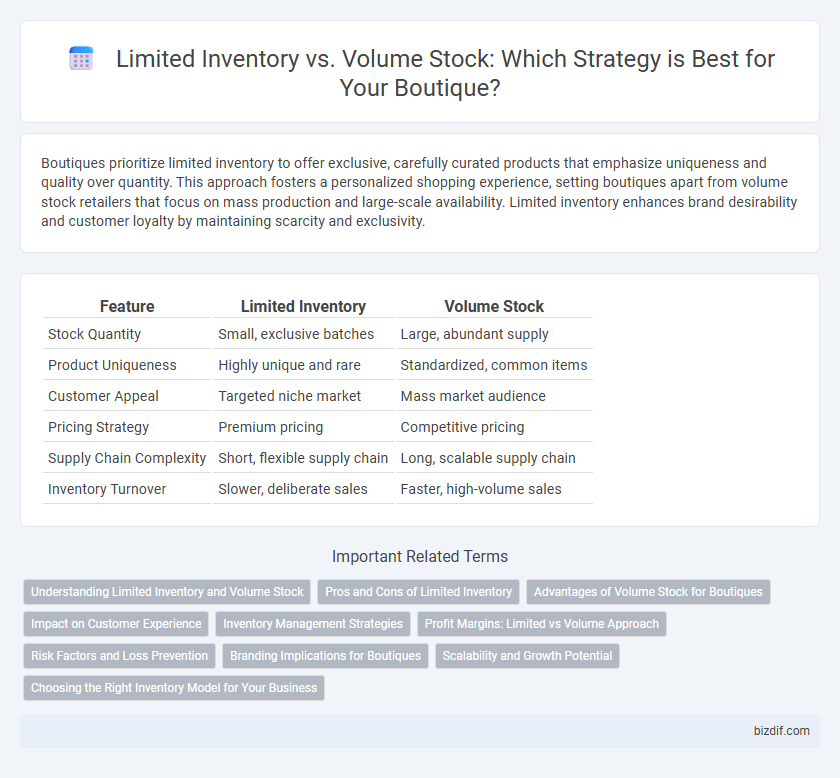Boutiques prioritize limited inventory to offer exclusive, carefully curated products that emphasize uniqueness and quality over quantity. This approach fosters a personalized shopping experience, setting boutiques apart from volume stock retailers that focus on mass production and large-scale availability. Limited inventory enhances brand desirability and customer loyalty by maintaining scarcity and exclusivity.
Table of Comparison
| Feature | Limited Inventory | Volume Stock |
|---|---|---|
| Stock Quantity | Small, exclusive batches | Large, abundant supply |
| Product Uniqueness | Highly unique and rare | Standardized, common items |
| Customer Appeal | Targeted niche market | Mass market audience |
| Pricing Strategy | Premium pricing | Competitive pricing |
| Supply Chain Complexity | Short, flexible supply chain | Long, scalable supply chain |
| Inventory Turnover | Slower, deliberate sales | Faster, high-volume sales |
Understanding Limited Inventory and Volume Stock
Limited inventory in a boutique refers to carefully curated, exclusive items available in small quantities, enhancing the sense of uniqueness and luxury. Volume stock involves larger quantities of popular products aimed at meeting higher demand without compromising availability. Understanding the balance between limited inventory and volume stock helps boutiques optimize customer satisfaction and maintain brand exclusivity.
Pros and Cons of Limited Inventory
Limited inventory in boutiques creates an exclusive shopping experience that appeals to customers seeking unique, high-quality items, enhancing brand prestige and customer loyalty. This approach reduces storage costs and minimizes overstock risks but may limit product variety and sales volume, potentially turning away price-sensitive or variety-driven shoppers. Balancing scarcity with demand is crucial for maximizing profitability and maintaining a boutique's distinctive market position.
Advantages of Volume Stock for Boutiques
Volume stock provides boutiques with a consistent supply of popular items, reducing the risk of stockouts and lost sales opportunities. Bulk purchasing often leads to cost savings through supplier discounts, enhancing profit margins and allowing competitive pricing. Maintaining a larger inventory enables boutiques to meet diverse customer demand promptly, improving customer satisfaction and driving repeat business.
Impact on Customer Experience
Limited inventory in boutiques creates an exclusive shopping environment that enhances perceived product value and encourages immediate purchase decisions. Volume stock offers broader selection and availability, reducing wait times but potentially diluting the uniqueness of the shopping experience. Balancing limited inventory with strategic volume stock can optimize customer satisfaction by combining exclusivity with convenience.
Inventory Management Strategies
Boutique inventory management strategies prioritize limited inventory to create exclusivity and reduce overstock risks, enhancing brand value and customer experience. Unlike volume stock approaches that focus on mass availability, limited inventory requires precise forecasting and agile restocking methods to maintain product scarcity and optimize turnover rates. Leveraging data analytics and demand sensing tools allows boutiques to align supply closely with niche market trends, minimizing holding costs and maximizing profitability.
Profit Margins: Limited vs Volume Approach
Limited inventory in boutiques often yields higher profit margins per item due to exclusivity and premium pricing strategies. Volume stock focuses on higher sales quantities with lower margins, relying on turnover rather than scarcity. Strategic inventory decisions balance these approaches to optimize overall profitability and brand positioning.
Risk Factors and Loss Prevention
Limited inventory in boutiques reduces risk exposure by minimizing excess stock and potential markdown losses, enhancing cash flow management. Volume stock increases the risk of overstocking, resulting in higher holding costs, inventory shrinkage, and potential obsolescence. Effective loss prevention strategies include precise demand forecasting, regular inventory audits, and implementing secure storage systems to mitigate theft and spoilage risks.
Branding Implications for Boutiques
Limited inventory fosters brand exclusivity and elevates perceived value by creating scarcity, which attracts discerning clientele seeking unique items. Volume stock emphasizes availability and affordability, potentially diluting brand prestige but allowing broader market reach and increased sales frequency. Boutiques leveraging limited inventory can strengthen their brand identity by highlighting craftsmanship and rarity, while those opting for volume stock risk undermining their boutique appeal by appearing more like mass retailers.
Scalability and Growth Potential
Limited inventory in boutiques enhances exclusivity and allows for high-margin pricing but restricts scalability due to constrained product availability. Volume stock supports rapid growth by enabling bulk purchasing and wider distribution, yet risks diluting brand uniqueness and customer experience. Balancing limited inventory with strategic volume stock ensures sustainable scalability while preserving boutique brand identity.
Choosing the Right Inventory Model for Your Business
Limited inventory cultivates exclusivity and higher profit margins by offering unique, carefully curated products that attract discerning customers and reduce storage costs. Volume stock supports mass-market sales through bulk purchasing, ensuring product availability and lower per-unit costs but risks overstock and reduced brand prestige. Evaluating factors such as target audience, cash flow, and storage capacity helps businesses select the optimal inventory model for sustainable growth and competitive advantage.
Limited Inventory vs Volume Stock Infographic

 bizdif.com
bizdif.com